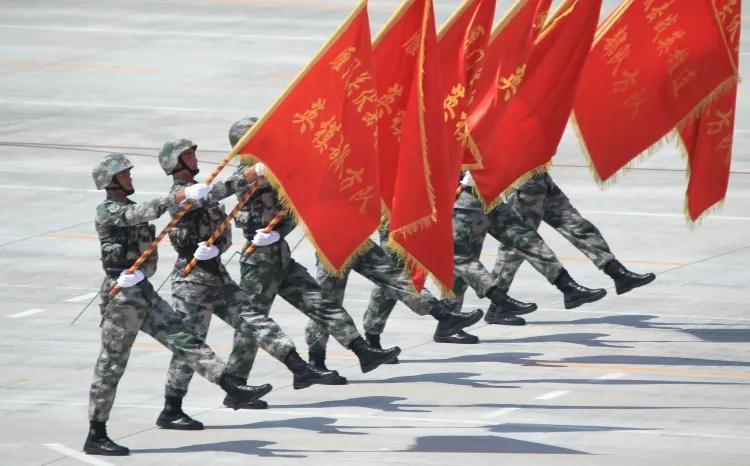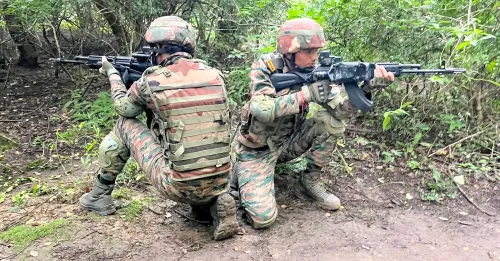Is Military Development in Tibet Threatening Local Ecosystems and Regional Climate Stability?

Synopsis
Key Takeaways
- The expansion of military activity in Tibet poses severe risks to local ecosystems.
- Permafrost degradation is accelerating due to military infrastructure.
- The Tibetan Plateau plays a crucial role in carbon sequestration and hydrological regulation.
- Environmental sensitivity mapping identifies vulnerable areas needing protection.
- Balancing military needs with ecological preservation is essential for regional stability.
Stockholm, Aug 18 (NationPress) The expansion of the Tibet military region underscores a critical intersection of geopolitical strategy and environmental preservation, presenting intricate challenges for both regional security and global climate dynamics, as highlighted in a recent report.
Current military development approaches in Tibet are inducing environmental changes that ripple far beyond the immediate military footprint. These changes jeopardize local ecosystems and threaten the regional climate stability and water security for communities residing downstream, according to the Stockholm-based Institute for Security and Development Policy (ISDP).
The report details that the Chinese military presence in Tibet has transitioned from initial force deployments in the 1950s to a sophisticated military network integrated into China's national defense strategy and economic framework. Assessments by the International Institute for Strategic Studies in 2023 estimate that the People's Liberation Army (PLA) maintains between 70,000 to 120,000 troops across the Tibetan Plateau, with approximately 40,000 to 50,000 stationed in the Tibet Military District. This troop distribution includes significant military bases and forward operating posts strategically located along border areas and essential transport routes.
Significant reorganizations within the military command structure in Tibet have occurred as part of China's military reforms. The ISDP report explains, “The arrangement of military facilities in Tibet reflects both defensive strategies and power projection capabilities.” Satellite imagery analysis conducted by the Centre for Strategic and International Studies has revealed substantial military installations across the plateau, each posing potential environmental risks.
The military infrastructure's impact has resulted in direct, quantifiable consequences for Tibet's delicate ecosystem. The report indicates, “The Tibetan Plateau encompasses around 1.06 million sq. km of permafrost, the largest high-altitude permafrost region globally, accounting for 40% of the Qinghai-Tibet plateau.” This permafrost is crucial for carbon sequestration and hydrological system regulation.
Field studies in military development zones have observed permafrost degradation, with increases in the active layer depth attributed to ground temperature rises between 0.1 to 0.5 degrees Celsius annually over the past three decades, with no measures taken in areas of significant military construction. The report cautions, “This degradation not only impacts local ecosystems but also contributes to greenhouse gas emissions through the release of previously stored carbon.”
The ISDP report emphasizes that addressing these challenges requires a fundamental reassessment of military infrastructure design, construction, and operation in this sensitive region. It advocates for prioritizing ecological preservation in military planning, particularly in glacier margins and stable permafrost zones.
“We must prioritize ecological preservation in military planning,” the report urges, “especially in glacier margins and stable permafrost zones. Environmental sensitivity mapping has identified around 35,000 sq. km of highly vulnerable terrain that should be excluded from intense military activities.” It recommends stricter environmental standards for military construction, including mandatory setbacks from sensitive water sources, bans on disruptive activities in permafrost areas, and comprehensive ecological restoration post-military exercises. Regular independent environmental impact assessments are also imperative. Investments should be directed toward environmentally sustainable military infrastructure, such as advanced waste treatment, energy-efficient facilities, and site-specific permafrost protection systems to mitigate ecological damage.
“We must recognize the broader implications of militarization in high-altitude environments,” the ISDP adds. Tibet’s environmental stability—especially its role in Asian water security—relies on balancing military expansion with ecosystem preservation. While recent environmental initiatives show promise, the rapid pace of development remains concerning. Enhancing transparency and cooperation with national and international NGOs is essential. Cross-border environmental impacts necessitate not just greater openness but also shared solutions and the exchange of best practices.”









